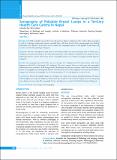Please use this identifier to cite or link to this item:
https://hdl.handle.net/20.500.14356/1476Full metadata record
| DC Field | Value | Language |
|---|---|---|
| dc.contributor.author | Jha, Anamika | - |
| dc.contributor.author | Lohani, Benu | - |
| dc.date.accessioned | 2023-05-14T07:45:53Z | - |
| dc.date.available | 2023-05-14T07:45:53Z | - |
| dc.date.issued | 2018 | - |
| dc.identifier.citation | JhaA., & LohaniB. (2019). Sonography of Palpable Breast Lumps in a Tertiary Health Care Centre in Nepal. Journal of Nepal Health Research Council, 16(41), 396-400. https://doi.org/10.33314/jnhrc.v16i41.1461 | en_US |
| dc.identifier.issn | Print ISSN: 1727-5482; Online ISSN: 1999-6217 | - |
| dc.identifier.uri | http://103.69.126.140:8080/handle/20.500.14356/1476 | - |
| dc.description | Original Article | en_US |
| dc.description.abstract | Abstract Background: With a palpable lesion in the breast, the goal is to diagnose malignancy at the earliest. Ultrasonography is used for evaluating symptomatic patients especially those with dense breasts where mammography gives limited information. The objective of this study was to evaluate the sonographic pattern of the palpable breast lumps and correlate with the final pathological diagnosis. Methods: This was a retrospective study done at our tertiary health care center, from July 2016 to March 2017, including 121 patients presenting to the ultrasound department with complaint of palpable breast lump and whose pathological reports could be followed up. Various sonographic features were studied, sonography and final diagnosis compared. Results: On sonography, about 46% of the cases were benign, 35 % malignant and 18 % indeterminate while tissue diagnosis revealed 63% to be benign, 34% malignant. The most common lesions in each group and sonographic characteristics were evaluated. Of the benign lesions, fibroadenoma was the most common. Most of the indeterminate lesions on sonography were histologically mastitis. We found nearly 58% of the malignant lesions had microlobulated margins. The sensitivity of sonography was 92.9% and specificity 97.5% with diagnostic accuracy 94.8%. Conclusions: Most of the palpable lumps were benign in our study, most common being fibroadenoma. We had a relatively higher percentage of malignancy which may be due to patients with obviously benign lesions not undergoing tissue diagnosis in our setting. The sonographic features and diagnosis correlated well with the histological diagnosis. Keywords: Breast cancer; lumps; ultrasonography. | en_US |
| dc.language.iso | en | en_US |
| dc.publisher | Nepal Health Research Council | en_US |
| dc.relation.ispartofseries | Oct-Dec 2018;1461 | - |
| dc.subject | Breast cancer | en_US |
| dc.subject | Lumps | en_US |
| dc.subject | Ultrasonography | en_US |
| dc.title | Sonography of Palpable Breast Lumps in a Tertiary Health Care Centre in Nepal | en_US |
| dc.type | Journal Article | en_US |
| local.journal.category | Original Article | - |
| Appears in Collections: | Vol. 16 No. 4 Issue 41 Oct - Dec 2018 | |
Files in This Item:
| File | Description | Size | Format | |
|---|---|---|---|---|
| 1461-Manuscript-7819-3-10-20190221.pdf | Fulltext Article. | 242.27 kB | Adobe PDF |  View/Open |
Items in DSpace are protected by copyright, with all rights reserved, unless otherwise indicated.
